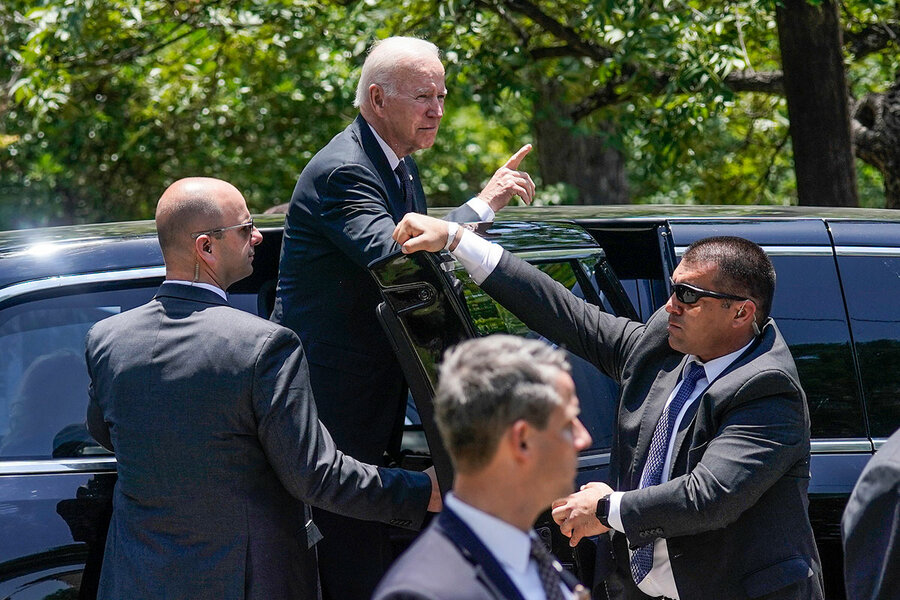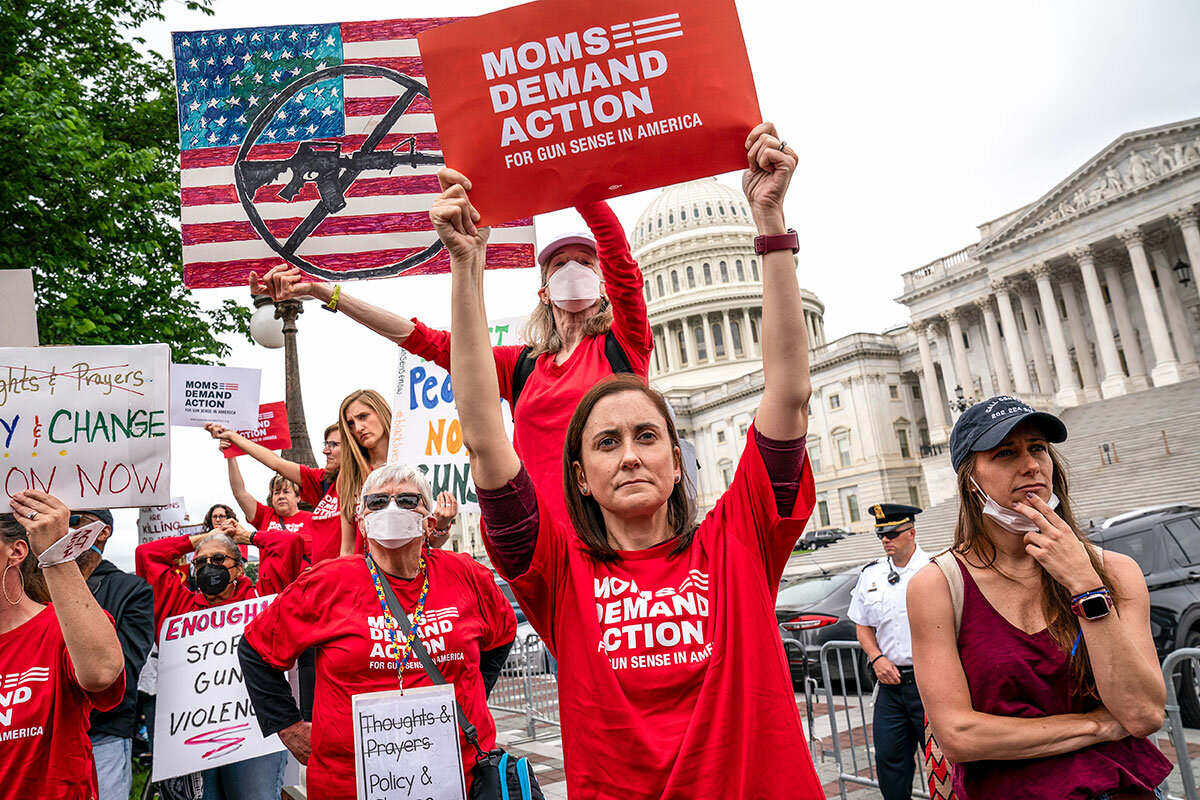Big problems, consensus solutions: Why so hard for Congress to act?
Loading...
| Washington
“Do something!” a protester cried out as President Joe Biden left a church service Sunday in Uvalde, Texas.
“We will,” the president responded, pointing to the demonstrators as he climbed into his limousine.
For the second time this month, President Biden and the first lady visited a grieving community following a gun massacre – first in Buffalo, New York, where a racist assailant killed 10 Black people at a grocery store, and then in Uvalde, where 19 elementary school children and two teachers were killed in the worst school shooting in nearly a decade.
Yet once again, the seeming disconnect over federal action on gun safety appears poised to play out. Overwhelming majorities of the public have long favored certain measures aimed at keeping firearms out of the hands of people who shouldn’t have them. And as in the aftermath of other mass shootings, expectations are slim to none that Congress will ultimately accomplish anything.
That protesters showed up for Mr. Biden’s visit to Uvalde is, in a way, a hopeful sign that people haven’t completely given up on government. So, too, is the March for Our Lives gun safety rally in Washington planned for June 11. The House Judiciary Committee will hold an emergency session Thursday on a package of gun measures. And bipartisan Senate leaders on the gun issue are conferring virtually this week, during their recess.
“Progress is possible,” Democratic Sen. Chris Murphy of Connecticut, a lead advocate for gun safety, said Sunday on ABC’s “This Week.”
History shows societal problems that once seemed unsolvable can, through painstaking advocacy – and questioning of long-held assumptions – be addressed. Airline hijackings, common in the 1960s and early ’70s, are now rare. The prevalence of smoking among adults has declined dramatically. Drinking and driving has been stigmatized, and new technologies offer hope for progress.
Democracy scholar William Howell takes the long view on systemic reform. “This is the work not of this calendar year, but of our generation,” says Professor Howell, director of the Center for Effective Government at the University of Chicago. He points to the Progressive era of the early 20th century, when a spate of new challenges sparked fundamental change in U.S. government institutions – including the presidency, the president’s relationship to Congress, and the rise of the modern administrative state.
“Incredibly transformative work was undertaken during that period,” Professor Howell says. “I wish those forces could be marshaled again.”
Still, the forces arrayed against even the most incremental steps to address gun violence are profound. Political polarization, lobbyists, Senate rules, and impassioned single-issue voters are all hindering action. Moreover, the roots of today’s seeming stasis lie, in part, in the wishes of the Founding Fathers, who sought to thwart a potential “tyranny of the majority” by constructing checks and balances within and among the branches of government.
Gun policies with public support
When it comes to gun policy proposals that enjoy strong public support – for example, 88% support for requiring background checks on all gun sales in the latest Politico/Morning Consult poll – the persistent failure of Congress to act speaks to “systemic dysfunction,” Professor Howell says.
This dynamic – where large majorities of Americans support certain policies on prominent issues, but Congress nevertheless fails to act – pertains not just to gun violence. On abortion rights, immigration reform, and climate change, long-running major polls of U.S. public opinion point to strong popular support for specific, middle-of-the-road solutions, and yet Congress has repeatedly failed to pass legislation.
The sources of this gridlock are multifold. Increasing political polarization and increasing uniformity of views within parties, exacerbated by gerrymandering of congressional districts, leave less room for compromise. In this polarized environment, members of Congress often fear the wrath of their voters if they take any position that bucks party orthodoxy. This is particularly so in primaries, where a challenger to an incumbent can promote more absolutist positions, and win over the activist base – especially when turnout is low.
Another factor goes to the original design of the Senate: Each state gets two senators, regardless of population size. Over time, population shifts have meant a shrinking portion of the American population elects a growing number of senators – a trend that gives disproportionate clout to more rural, conservative states.
“We’re getting close now to a point where 70% of Americans will live in 15 states. That means 30% of Americans elect 70 senators,” says Norman Ornstein, emeritus scholar of government at the American Enterprise Institute. “It’s certainly part of the growing sense of illegitimacy of the political system.”
Layered on this phenomenon of growing “malapportionment” is the filibuster, the longstanding Senate mechanism that requires a supermajority of 60 votes to pass most legislation. With the Senate’s partisan split at 50-50, that makes all but the most essential legislation well nigh impossible to pass. Talk of filibuster reform has foundered.
At this point, it’s easy to get discouraged about the state of American democracy. There are things presidents can do on their own via executive action. Last month, Mr. Biden cracked down on untraceable “ghost guns.” President Donald Trump banned “bump stocks,” which allow a weapon to fire in rapid succession, after the 2017 massacre in Las Vegas.
But other ideas on the table require Congress to enact. In addition to expanding background checks for gun buyers, the bipartisan group of senators meeting virtually this week is looking at ways to incentivize more states to pass so-called red flag laws, which allow a court to remove firearms from someone deemed potentially dangerous.
Some measures that poll well are reportedly off the table for now, including raising the age for the purchase of semiautomatic weapons to 21. The shooters in Buffalo and Uvalde were both 18.
The Second Amendment to the Constitution, which guarantees the right to bear arms, looms large over efforts to regulate firearms. Earlier this month, a federal appeals court struck down a California law banning the sale of some semiautomatic weapons to people under 21.
And in the Supreme Court, observers expect the new conservative supermajority to broaden Second Amendment rights soon in a New York handgun case – the high court’s first major ruling on gun rights in more than a decade. Trump-appointed jurists are key to the outcomes in both cases, and represent an important part of the former president’s legacy.
“The ability of legislatures to make policy depends on those laws being upheld in courts,” says Susan Liebell, political science chair at Saint Joseph’s University in Philadelphia.
“And when you have minority control in the U.S. Senate,” she adds, referring to malapportionment, “that creates a judiciary that does not reflect the views of the majority of Americans.” Professor Liebell notes, too, that Mr. Trump won the Electoral College in 2016 without a majority of the popular vote, adding another “minority” aspect to his judicial nominees.
Abortion, the judiciary, and Congress
Abortion is another hot-button social issue that is running into Mr. Trump’s legacy. As with gun rights, the three justices appointed by Mr. Trump are expected soon to tip the balance in a major abortion ruling – one overturning the Supreme Court ruling establishing a nationwide right to abortion.
Polling consistently shows strong public support for abortion rights, with limits. But Congress has failed to act in a way that would codify in law the court’s two key abortion precedents, Roe v. Wade and Planned Parenthood v. Casey.
A recent Senate vote on legislation advertised as codification of Roe and Casey, in fact, was not. It was more expansive, and went down 49-51, failing even to win the votes of two Republican senators who support abortion rights. The vote was seen as largely symbolic, and for some Democrats, aimed at creating fodder for the November midterm elections.
The practice of ginning up campaign issues, not solutions, is common, and yet another cause for discouragement among democracy scholars. The approaching midterms may well present another roadblock to action on gun violence.
“Republicans don’t really want to solve this problem, because that potentially demobilizes people before the election,” says Lee Drutman, a senior fellow at the New America think tank. “Democrats also don’t really want to solve the problem either – or at least enough of them don’t – because it’s a great campaign issue.”
Still, the horrific nature of recent events gives some veteran Congress-watchers faint hope for at least a modest measure aimed at reducing gun violence.
“I think there’s a small chance that we’ll get some kind of watered-down gun bill that will get 60 votes,” says Mr. Ornstein, referencing legislation on background checks. “A small chance.”







